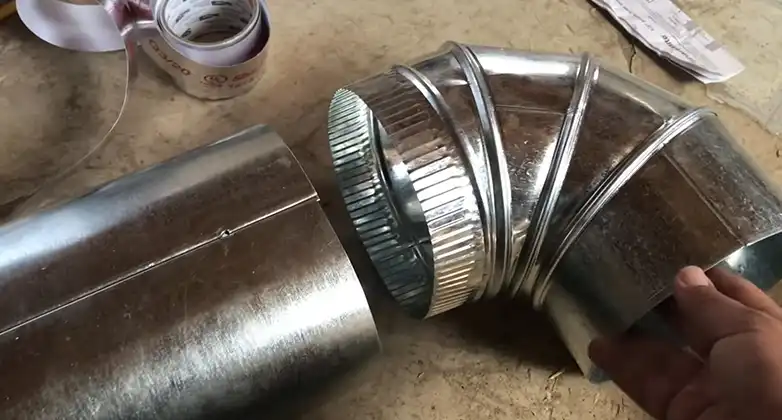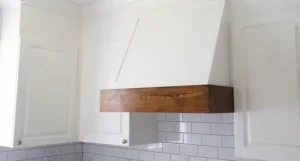Proper ventilation is a crucial aspect of any kitchen, and range hoods play a vital role in keeping your kitchen air clean and free from smoke, odors, and grease particles. When installing or replacing a range hood, it’s important to choose the right materials for venting.
While PVC pipe may seem like a cost-effective option, there are several reasons why you shouldn’t use PVC for range hood venting.
In this article, we’ll explore the risks associated with PVC pipe, safer alternatives for venting, and answer some common questions about this topic.

Why You Shouldn’t Use PVC Pipe for Range Hood Venting
Choosing PVC for range hood venting can pose safety risks – here’s why
Temperature Resistance
One of the primary reasons why PVC pipe is not suitable for range hood venting is its limited temperature resistance. PVC pipes have a low melting point, typically around 140-160°F (60-71°C). Range hoods can produce much higher temperatures, especially when cooking with high heat or using self-cleaning oven features. This excessive heat can cause PVC pipes to soften, deform, or even melt, leading to potential hazards and damage to your ventilation system.
Fire Safety Concerns
PVC is not fire-resistant, and if exposed to high temperatures, it can ignite, leading to a dangerous fire in your kitchen or home. The risk of fire associated with PVC pipe in range hood venting is a serious safety concern, making it an unsuitable choice for this application.
Odor Absorption
PVC has a tendency to absorb odors over time. In the kitchen, where various cooking aromas can linger, using PVC for venting can result in unwanted smells being released into your home. This is not only unpleasant but also counterproductive to the purpose of a range hood, which is to remove odors and improve air quality.
Building Code Compliance
Many building codes and regulations prohibit the use of PVC pipe for range hood venting due to the safety concerns mentioned above. Using PVC for this purpose may not pass inspection, leading to potential legal and safety issues.
Safer Alternatives for Range Hood Venting
Now that we’ve discussed why PVC pipe is not recommended for range hood venting, let’s explore some safer alternatives:
Rigid Metal Ductwork
Rigid metal ductwork, typically made of materials such as galvanized steel or aluminum, is a widely accepted and safe choice for range hood venting. These materials have excellent temperature resistance, are fire-resistant, and won’t absorb odors. They are also less likely to accumulate grease buildup compared to PVC.
Flexible Aluminum Ducts
Flexible aluminum ducts are suitable for range hood venting in situations where rigid ductwork is not feasible due to space constraints or the need for flexibility in installation. These ducts are made of aluminum and are designed to handle the high temperatures generated by range hoods.
Ductless Range Hood
If you are unable to install ductwork for venting, consider using a ductless range hood. Ductless range hoods use filters to trap grease and odors and then recirculate the cleaned air back into the kitchen. While not as effective as vented hoods, they are a safer option than using PVC pipes for venting.
People Also Ask
Can I use PVC pipe for range hood venting if it’s insulated or enclosed?
Even if you insulate or enclose PVC pipe, it is still not recommended for range hood venting due to its limited temperature resistance and fire safety concerns. It’s best to choose materials designed for high-temperature applications, such as rigid metal ductwork or flexible aluminum ducts.
Are there any PVC alternatives with higher temperature resistance?
Some high-temperature PVC alternatives exist, such as CPVC (chlorinated polyvinyl chloride) or ABS (acrylonitrile butadiene styrene), but these are still not ideal choices for range hood venting. They may have slightly higher temperature resistance than standard PVC but are not as robust as metal options.
What are the consequences of using PVC for range hood venting?
Using PVC for range hood venting can lead to several negative consequences, including the risk of the pipe melting or deforming, fire hazards, the absorption of cooking odors, and non-compliance with building codes. It can compromise safety and air quality in your home.
Can I retrofit my existing PVC venting with safer materials?
Yes, it is possible to retrofit your existing PVC venting with safer materials like rigid metal ductwork or flexible aluminum ducts. Consulting with a professional installer is recommended to determine the best approach for your specific situation.
End Notes
Range hood venting is a critical component of any kitchen ventilation system, and the choice of materials for venting is essential for safety and efficiency. PVC pipe is not a suitable option due to its limited temperature resistance, fire safety concerns, odor absorption, and non-compliance with building codes.
To ensure safe and effective range hood venting, it is best to opt for materials specifically designed for high-temperature applications, such as rigid metal ductwork or flexible aluminum ducts. Always consult with professionals who can assess your unique requirements and local building codes to make the right choice for your kitchen. Prioritizing safety in your range hood venting system will help keep your kitchen air clean and your home secure.


